- Home
- Jerry Spinelli
Knots in My Yo-Yo String Page 3
Knots in My Yo-Yo String Read online
Page 3
I was eleven when I first played Little League baseball. To give as many kids as possible a chance to participate, the Little League declared that some of us would share uniforms with others. And so the season was exactly half over when I pedaled my bike up to Albert Pascavage’s house to pick up his uniform: green socks, green cap, gray woolen shirt, and pants with green trim. I packed my precious cargo into my bike basket and drove it carefully home. I was a member of the Green Sox.
During one game in that half season I played second base—apparently no one told the manager I was going to be a major league shortstop. Our opponent was the Red Sox. The batter hit a ground ball right at me. I crouched, feet spread, glove ready, as I had been taught in the Times Herald baseball school. I could hear the ball crunching along the sandy ground. It hit my glove—but not the pocket. Instead it glanced off the fat leather thumb and rolled on behind me.
Shortshop, Green Sox (age 12, 1953).
My first error!
I was heartbroken. I stomped my foot. I pounded my fist into the stupid glove.
When the inning was over and I slunk to the Green Sox bench, the manager was waiting for me. I thought he was going to console me. I thought he would say, “Tough luck, Jerry. Nice try,” and then tousle my hair.
That’s not what happened.
What he really did was glare angrily at me, and what he really said was, “Don’t you ever do that again.” He pointed out that while I was standing there pounding my glove, two Red Sox runs had scored. “Next time you miss the ball, you turn around and chase it down. You don’t just stand there feeling sorry for yourself. Understand?”
I nodded. And I never forgot.
Like most of the kids in my class, I got better at sports simply by growing older. I went from being one of the worst players in Little League as an eleven-year-old to making the all-star team as a twelve-year-old. The following year I was the only seventh grader to start on the Stewart Junior High School team—at shortstop, of course. It mattered little that I was not very good at hitting a curve ball, since most pitchers threw only fastballs.
During the summer of junior high school I played in a baseball league called Connie Mack Knee-Hi, for thirteen- to fifteen-year-olds. Before each game, one team would line up along the first-base line, the other team along third base. The umpire stood on the pitcher’s mound, took off his cap, and read aloud the Sportsmanship Pledge, pausing after each line so the rest of us could repeat it in chorus. We pledged ourselves to be loyal to, among other things, “clean living and clean speech.” In the final line we promised to be “a generous victor and a gracious loser.”
In the Knee-Hi summer of 1955, I had little chance to be a gracious loser. My team, Norristown Brick Company, swept through the local league undefeated, winning our games by an average score of 12–1. One score was 24–0. One team simply refused to show up. Our pitchers threw four no-hitters, three by Lee Holmes. Opposing batters could no more hit Bill Bryzgornia’s fastball than spell his name. We were a powerhouse.
We beat Conshohocken two out of three to gain the state playoffs. Three wins there put us into the title game. On a bright Saturday afternoon at War Memorial Field in Doylestown, Norristown Brick Company defeated Ellwood City, 4–2, to become Connie Mack Knee-Hi champions of Pennsylvania.
In the awards ceremony after the game, we were given jackets saying STATE CHAMPIONS. Ellwood City players got trophies. A jacket would eventually wear out and be thrown away, leaving me with nothing to show for our great triumph. But a trophy was immune to frayed cuffs and moth holes. A trophy would be forever. I watched as each Ellwood City player walked up for his trophy and half-wished I had been on the losing side.
A week later, during a banquet at the Valley Forge Hotel in downtown Norristown, to my relief, we were each given a magnificent trophy.
Two buddies (Anthony Greco and Bob Hopple) and me (left), heading off to dance at Grace Lutheran Church, 1955. I’m wearing my Knee-Hi State Champions jacket.
Chucking dust on a four-base diamond was only part of the baseball life. There was the long list of major league batting averages to pore over each Sunday in The Philadelphia Inquirer. There was the baseball encyclopedia, my first history book, to study. Long before I knew the difference between Yorktown and Gettysburg, I knew Ty Cobb’s lifetime batting average (.367) and Cy Young’s total career pitching victories (511).
There were cards to flip. We bought Fleer’s bubblegum just to get the baseball cards, and then we dueled. Slip one corner of the card between forefinger and middle finger and flip outward, Frisbee-like, toward a wall. The kid whose card lands closest to the wall picks up the other kid’s card. The stacks of cards I won this way would be worth a fortune today if I had kept them.
There were baseballs to tape. Seldom in our sandlot games did we have a ball with a real stitched horsehide cover still on it. Most often the balls were covered in black utility tape. A white ball was a real treat. It meant that someone had sneaked into the medicine chest at home and used up half a roll of first-aid tape.
There were hours to spend bouncing tennis balls off neighbors’ brick walls, any wall but that of the mysterious barber across the street. For hours each week I scooped up the rebounding grounders, practicing to be a great shortstop. Considering the thumping I gave those houses, it’s a wonder I was never chased off. Maybe the people behind the walls understood that in my mind I was not really standing on George Street but in the brown dust of Connie Mack Stadium, out at shortstop, fielding hot shots off the bat of Willie Mays.
And there was the glove. My glove bore the signature of Marty Marion, slick-fielding shortstop of the St. Louis Cardinals.
Each year at the end of summer vacation, I rubbed my glove with olive oil from the kitchen cabinet. Then I pressed a baseball deep into the pocket of the glove, curled the leather fingers about the ball, and squeezed the whole thing into a shoebox. Standing on a chair, I set the box high on a closet shelf. Baseball season was officially over.
For the next six months we would hibernate, shortstop and glove, dreaming of the Chiclets-white bases at Connie Mack Stadium, feeling in the palm the hard, round punch of a grounder well caught.
Good
Boy
Like cowboys and then sports, grade school was a constant presence in my life, though not an especially interesting one. It seems to me that most interesting stories about grade school are told by kids who got in trouble. I never got in trouble. I was, as they say, a Good Boy.
But what is a Good Boy? From the world’s point of view, it is a boy who appears to be good. The key word here is appears. For I believe that beneath the appearance of most Good Boys is a Bad Boy waiting to break out. Oh, I don’t mean bad in the sense of committing crimes or hurting people. I mean bad in the sense of, say, leaving a wad of chewing gum on the teacher’s chair. Or washing the blackboard with spit. Or jumping up from your seat in the middle of silent reading, standing on top of your desk, raising your fists to the ceiling, and roaring with all your might, “Phooey!”
That kind of bad.
Let me tell you something about the Good Boy: Just because he doesn’t get into trouble doesn’t mean he doesn’t appreciate trouble. I know I did. I understood what a boring world this would be without the troublemakers. And so I was a big fan of Leonard Wilfong, who was always getting into trouble. I didn’t exactly stand up and applaud when Leonard did something bad, but I gave him my undivided attention, and if I thought I could get away with it, I laughed.
To the Bad Boy, that’s the reward: laughter. It’s the payoff of a deal that is never spoken of, never written down, yet is understood perfectly by the kids in class. It’s as if back on the first day of first grade, all the boys had a secret meeting and one of them was voted to be Bad Boy. He—in our case, Leonard Wilfong—accepted the job, along with the punishments that would surely fall to him, with the understanding that the rest of us would (1) pay attention and (2) laugh.
And the meeting broke up and Leonard W
ilfong went forth and did outrageous things, and we laughed. Neither Leonard nor the rest of us understood this, but in a sense we were laughing at ourselves, for Leonard Wilfong was the embodiment of the Bad Boy in all of us. Leonard did what we did not have the nerve to do. Leonard did not have the same fears we had. He feared spelling tests and long division and report cards. He did not fear trouble. He did not fear rules. And though we did not envy Leonard Wilfong his punishments or his bad grades, we absolutely envied him his recklessness. We respected him as the representative of that which was secret in ourselves. We saluted him with our attention and our laughter.
When the teacher wasn’t looking.
At age 6 (1947): a Good Boy in the making.
So if you want an interesting Hartranft Elementary School autobiography from those days, go see Leonard Wilfong. As for me, I have already mentioned the fifty-yard dash and my spur-song serenade. Only four other interesting things happened to me in grade school:
1. Second grade. This did not happen directly to me but to a calf. Mrs. Care, our teacher, lived on a farm. One spring day she took the whole class there for a visit. While jumping into the hay in the barn, Roger Adelman landed on a pitchfork and had to go to the hospital. Ordinarily, that would have been the highlight of the day, but out in the barnyard something even more interesting was happening.
A mother cow and her calf were hanging around just inside the fence, close enough for some of us to reach out and touch. Then, as we watched in amazement, the mother—who, you must understand, was a lot taller than her offspring—backed up to the calf and pooped on its head. Until Mrs. Care finally wiped it off, the plop just stayed there, like a brown beret. Was it my imagination, or did the calf really have an expression on its face, as if to say, “Hey, Ma—wha’d I do?”
2. Second grade. We had a student teacher from West Chester University. Though she was careful not to give me preferential treatment, I remember feeling proud and special. Why? She was my cousin, Dolly.
3. Third grade. I got sick with a kidney ailment. I was in the hospital for ten days and out of school for two months. My mother tells me that in the hospital I put on a brave front. She says that whenever she and my father visited me, I chatted away happily with them. Then, the second they left the room, I started to cry. My mother found this out from the nurses. Personally, I don’t remember. My mother also says they gave me so many needles in the hospital that my rear end looked like a pincushion. I don’t remember that either. As a reward for all the needles each night, a smiling nurse in a candy-striped uniform brought me a milkshake. That I remember.
4. Sixth grade. In early spring of that year the two sixth grades were brought together for a series of spelling bees. Since I won more of them than anyone else, I was declared spelling champion of Hartranft Elementary. That honor earned me the chance to compete in the Montgomery County spelling bee, the winner of which would go to Washington, D.C., for the national bee.
As a sixth grader among contestants ranging up to eighth grade, I was one of the youngest on the stage at Norristown High School that night in April 1953. I don’t think it ever occurred to me to try to win. My goal was to survive until at least the fourth round, since I had been told that no one from Hartranft had ever gotten that far.
Ninety-six school champions sat in long curved rows of folding chairs. Hanging on a string from everyone’s neck was a square of white cardboard with a large black number. Mine was thirteen. Before the competition began, the master of ceremonies announced to the auditorium that we were honored to have last year’s county champion with us—Nancy Ann Hammerschmidt of North Wales. He then turned from the audience to the stage and asked Nancy Ann to stand and take a bow, and who should stand up but number twelve, the pretty blond older girl sitting next to me.
The competition got under way. The opening words were easy, and most of us made it through the first two rounds. Then we started dropping like flies. When somebody misspelled a word—bong!—the judge hammered a big brassy bell and the kid was gone. No arguing, no whining—wham, bam, next, please.
Meanwhile back in the seats Nancy Ann Hammerschmidt and I were chatting away. Actually, Nancy Ann did most of the chatting. I mostly nodded and smiled in wonder that the famous, glamorous fourteen-year-old champion would be so familiar with the likes of me. When we returned to our seats after nailing our third-round words, Nancy Ann took out her wallet and showed me a picture of her boyfriend.
When in the fourth round Nancy Ann spelled “ecstasy” with a second c instead of an s, I was sure no bong would dare banish her from the stage. But it did, and off she marched. And so did I a few seconds later, having spelled lacquer “l-a-c-q-u-o-r.” Considering how smitten I was with Nancy Ann, I’m surprised I even bothered to take my last turn at the mike before following her off the stage. She must have made a quick exit, though, for she was not among the growing crowd of misspellers behind the curtain, nor did I ever see her again. I guess neither Nancy Ann Hammerschmidt nor the spelling bee bonger cared that I was a Good Boy.
George
Street
Baseball is still baseball, and school is school, but George Street is no more. Oh, sure, if you travel to Norristown today and go west on Elm, you’ll come to a street sign that says GEORGE. Don’t believe it.
A street sign does not make a street. A time makes a street, and a people of that time. The sign will tell you nothing, nor will the people who live there today. Go ahead, ask them. Ask them whose front steps they better not sit on. Challenge them to a game of chew-the-peg. (Flip penknife from shoulder. If it doesn’t stick in ground, pull out planted peg with teeth.) Or just stand there on the sidewalk outside 802 and close your eyes and listen for the avalanche of coal. Listen for days. You won’t hear it. George Street is as gone as 1950.
I heard it. I heard it on coal day. Nearly every house on the block had a coal-burning furnace. In a front corner of the cellar, beneath the living room, was a plank-walled bin. It held a ton of coal. When the coal truck came, my job was to run to the cellar and open the window above the bin. The truck turned sideways in the street and backed up to the curb. From under the truck bed the coal man pulled the chute, which looked like a sliding board, and fed it through the open cellar window and into our bin. He lifted the hatch and the coal started coming, avalanching down the chute with such a racket that I had to clamp my hands over my ears. I had to tie a hanky around my nose, too, because of the coal dust that made a black, choking blizzard. I would crouch down under the washtub, fold my arms about my head, and wait out the bombardment from the enemy battleship and its sixteen-inch guns. Or if I wasn’t pretending that day, I simply ran outside.
Softer sounds came from the Victrola. The Victrola was an early phonograph, a record player. Ours was portable, like a small boxy suitcase. Whenever I lifted the hinged cover I was treated to a special scent, a sweet dustiness that suggested slumbering songs, music’s bunkhouse. To get the thing to work I had to crank it, like an old Model T Ford. The crank was a stepped metal rod with a black wooden egg-shaped handle. I placed a record on the turntable, then inserted the rod into a hole in the side of the player and cranked away. I flipped a switch, and the record began to spin. Breathlessly I lowered the needle to the smooth black edge of the disc. The needle slipped into the first groove, and “Too-ra-loo-ra-loo-ral”… Bing Crosby was crooning.
The main sound machine, of course, was the radio. Unlike many people my age, I cannot give a long list of the programs I listened to. What I do recall are three motifs: the Lone Ranger theme song, otherwise known as the William Tell Overture, footsteps walking down hallways, and doors creaking open. Beyond that I simply remember listening. And picturing.
For radio was a partnership. The radio furnished the sounds, and the listener supplied the pictures. TV and movie screens have shaded us from the evocative power of sound. Our eyes enslave us. “Seeing is believing.” In contrast to TV, which asks us merely to turn it on and become a passive dartboard, radio asked us to meet it h
alfway, to co-create the moment. The resulting pictures in our heads had a depth of reality possible only when the camera is the person.
Despite my love of radio, I soon gave in to the lure of television.
The first TV set in my corner of the West End belonged to the Beswicks up on Kohn Street, a block west of George. Butchie Beswick’s popularity zoomed. Day after day a mob of kids sat on the Beswick living room rug after school, goggle-eyed and gaping like so many guppies at Willie the Worm on the ten-inch black and white screen. Mrs. Beswick must have been a saint. Over time the mob diminished, one cross-legged floor-sitter at a time, as new families acquired television sets.
Our family got one in 1950—a twelve-inch Magnavox—when I was in third grade and home with my kidney illness. Doctor’s orders confined me to my bed, but I made such a fuss that I was finally allowed to be carried downstairs and plopped in a chair to watch TV for one hour, not a minute more.
Television and I grew up together; meanwhile movies seduced me with Technicolor and 3-D and CinemaScope. By the time I got my driver’s license, the only radio in my life was in the family car.
On July 20, 1969, Apollo 11 astronauts rode the lunar module Eagle to the surface of the moon. Like much of the world, I was in front of a TV set watching fuzzy images of the event: Eagle launching from the mother spacecraft, Eagle orbiting the moon, Eagle coming in lower, lower, skimming lunar hills and craters, seeking a spot to land. I strained my eyes watching, and still I wasn’t seeing, not well enough … the pictures in my head. I rushed outside to my car, I turned on the radio, and that’s where I experienced the landing on the moon. I had rediscovered what I knew back on George Street: listening is believing.

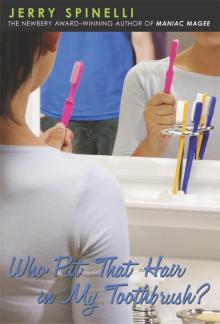 Who Put That Hair in My Toothbrush?
Who Put That Hair in My Toothbrush?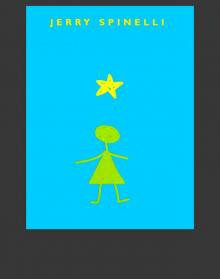 Stargirl
Stargirl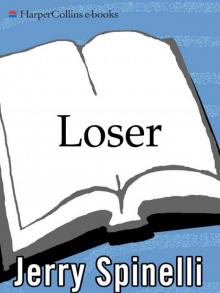 Loser
Loser Jake and Lily
Jake and Lily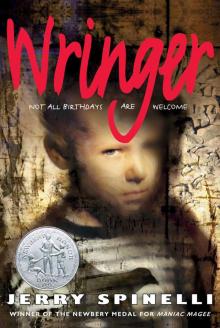 Wringer
Wringer Maniac Magee
Maniac Magee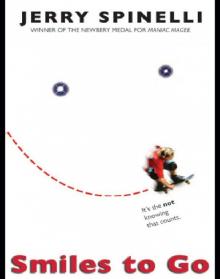 Smiles to Go
Smiles to Go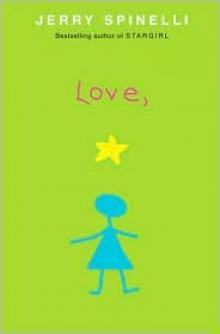 Love, Stargirl
Love, Stargirl Hokey Pokey
Hokey Pokey Third Grade Angels
Third Grade Angels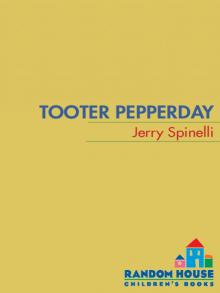 Tooter Pepperday: A Tooter Tale
Tooter Pepperday: A Tooter Tale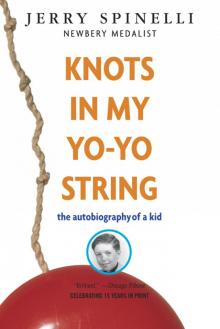 Knots in My Yo-Yo String Knots in My Yo-Yo String
Knots in My Yo-Yo String Knots in My Yo-Yo String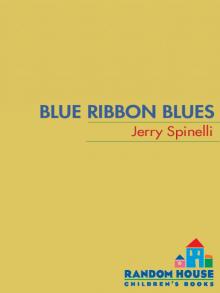 Blue Ribbon Blues: A Tooter Tale
Blue Ribbon Blues: A Tooter Tale The Bathwater Gang
The Bathwater Gang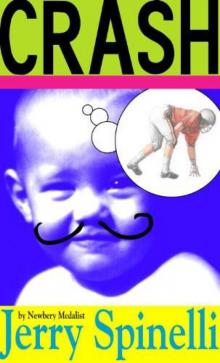 Crash
Crash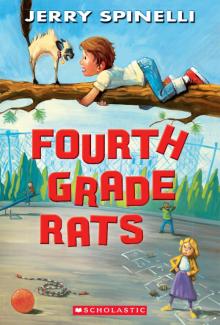 Fourth Grade Rats
Fourth Grade Rats Eggs
Eggs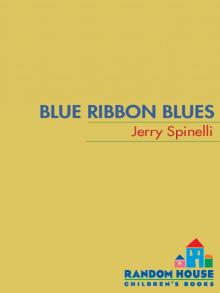 Blue Ribbon Blues
Blue Ribbon Blues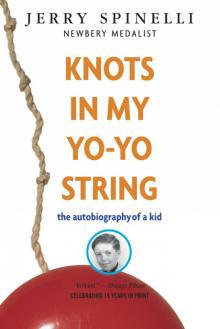 Knots in My Yo-Yo String
Knots in My Yo-Yo String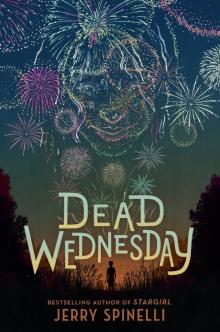 Dead Wednesday
Dead Wednesday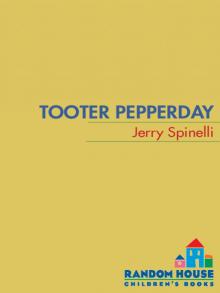 Tooter Pepperday
Tooter Pepperday